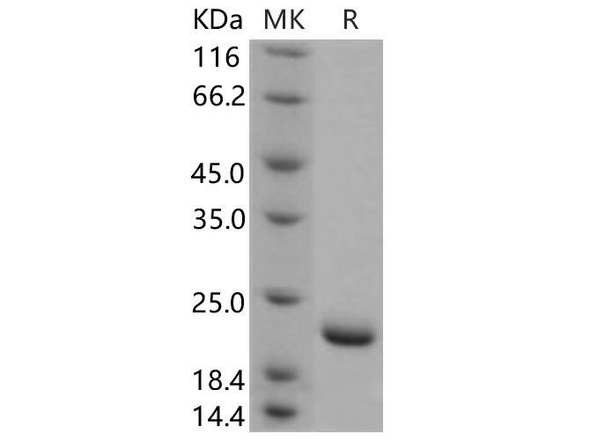Description
| Product Name: | Human SUMO1 Recombinant Protein |
| Product Code: | RPPB4877 |
| Size: | 50µg |
| Species: | Human |
| Target: | SUMO1 |
| Synonyms: | Small ubiquitin-related modifier 1, SUMO-1, Sentrin, Ubiquitin-like protein SMT3C, SMT3 homolog 3, Ubiquitin-homology domain protein PIC1, Ubiquitin-like protein UBL1, GAP-modifying protein 1, GMP1, SUMO1, SMT3C, SMT3H3, UBL1, PIC1, SMT3, DAP-1, OFC10, SENP2. |
| Source: | Escherichia Coli |
| Physical Appearance: | Sterile Filtered clear solution. |
| Formulation: | 10mM sodium chloride, 100mM imidazole, 0.5mM PMSF, 1mM DTT and 10% glycerol. |
| Stability: | Store at 4°C if entire vial will be used within 2-4 weeks. Store, frozen at -20°C for longer periods of time.�For long term storage it is recommended to add a carrier protein (0.1% HSA or BSA).Avoid multiple freeze-thaw cycles. |
| Purity: | Greater than 98.0% as determined by(a) Analysis by RP-HPLC.(b) Analysis by SDS-PAGE. |
SUMO1 is a protein that belongs to the SUMO (small ubiquitin-like modifier) protein family. SUMO1 functions in a manner similar to ubiquitin in that it is bound to target proteins as part of a post-translational modification system. Still, unlike ubiquitin which targets proteins for degradation, SUMO1 is involved in a variety of cellular processes, for example nuclear transport, transcriptional regulation, apoptosis, and protein stability. SUMO1 is not active until the last four amino acids of the carboxy-terminus are cleaved off.
The active human SUMO-I (the 1-97 animo acid region of the Ubiquitin-like protein SMT3C precursor). The enzyme contains a single polypeptide band of 11 kDa. The predicted molecular weight of hSOMO I is 11 kDa. The The final fraction of enzyme contains single polypeptide band of approximately 20 kDa on SDS PAGE.
| UniProt Protein Function: | SUMO1: Ubiquitin-like protein that can be covalently attached to proteins as a monomer or a lysine-linked polymer. Covalent attachment via an isopeptide bond to its substrates requires prior activation by the E1 complex SAE1-SAE2 and linkage to the E2 enzyme UBE2I, and can be promoted by E3 ligases such as PIAS1-4, RANBP2 or CBX4. This post-translational modification on lysine residues of proteins plays a crucial role in a number of cellular processes such as nuclear transport, DNA replication and repair, mitosis and signal transduction. Involved for instance in targeting RANGAP1 to the nuclear pore complex protein RANBP2. Polymeric SUMO1 chains are also susceptible to polyubiquitination which functions as a signal for proteasomal degradation of modified proteins. May also regulate a network of genes involved in palate development. Interacts with SAE2, UBE2I, RANBP2, PIAS1 and PIAS2. Interacts with PARK2. Covalently attached to a number of proteins such as IKFZ1, PML, RANGAP1, HIPK2, SP100, p53, p73-alpha, MDM2, JUN, DNMT3B and TDG. Also interacts with HIF1A, HIPK2, HIPK3, CHD3, EXOSC9, RAD51 and RAD52. Interacts with USP25 (via ts SIM domain); the interaction weakly sumoylates USP25. Belongs to the ubiquitin family. SUMO subfamily. |
| UniProt Protein Details: | Protein type:Nuclear receptor co-regulator; Ubiquitin-like modifier Chromosomal Location of Human Ortholog: 2q33 Cellular Component: nucleoplasm; PML body; nuclear membrane; dendrite; cytoplasm; nucleolus; fibrillar center; synapse; nuclear speck; nuclear pore; nucleus Molecular Function:protein binding; ubiquitin protein ligase binding; transcription factor binding; SUMO ligase activity Biological Process: negative regulation of transcription factor activity; cytokine and chemokine mediated signaling pathway; PML body organization and biogenesis; palate development; post-translational protein modification; DNA repair; negative regulation of DNA binding; regulation of protein localization; positive regulation of protein complex assembly; cellular protein metabolic process; protein sumoylation; positive regulation of proteasomal ubiquitin-dependent protein catabolic process; negative regulation of transcription, DNA-dependent Disease: Orofacial Cleft 10 |
| NCBI Summary: | This gene encodes a protein that is a member of the SUMO (small ubiquitin-like modifier) protein family. It functions in a manner similar to ubiquitin in that it is bound to target proteins as part of a post-translational modification system. However, unlike ubiquitin which targets proteins for degradation, this protein is involved in a variety of cellular processes, such as nuclear transport, transcriptional regulation, apoptosis, and protein stability. It is not active until the last four amino acids of the carboxy-terminus have been cleaved off. Several pseudogenes have been reported for this gene. Alternate transcriptional splice variants encoding different isoforms have been characterized. [provided by RefSeq, Jul 2008] |
| UniProt Code: | P63165 |
| NCBI GenInfo Identifier: | 52783799 |
| NCBI Gene ID: | 7341 |
| NCBI Accession: | P63165.1 |
| UniProt Secondary Accession: | P63165,P55856, Q6FGG0, Q6NZ62, Q93068, A8MUS8, B2R4I5 |
| UniProt Related Accession: | P63165 |
| Molecular Weight: | 101 |
| NCBI Full Name: | Small ubiquitin-related modifier 1 |
| NCBI Synonym Full Names: | small ubiquitin-like modifier 1 |
| NCBI Official Symbol: | SUMO1�� |
| NCBI Official Synonym Symbols: | DAP1; GMP1; PIC1; SMT3; UBL1; OFC10; SENP2; SMT3C; SMT3H3�� |
| NCBI Protein Information: | small ubiquitin-related modifier 1; sentrin; SMT3 homolog 3; GAP modifying protein 1; ubiquitin-like protein UBL1; ubiquitin-like protein SMT3C; SMT3 suppressor of mif two 3 homolog 1; ubiquitin-homology domain protein PIC1 |
| UniProt Protein Name: | Small ubiquitin-related modifier 1 |
| UniProt Synonym Protein Names: | GAP-modifying protein 1; GMP1; SMT3 homolog 3; Sentrin; Ubiquitin-homology domain protein PIC1; Ubiquitin-like protein SMT3C; Smt3C; Ubiquitin-like protein UBL1 |
| Protein Family: | Small ubiquitin-related modifier |
| UniProt Gene Name: | SUMO1�� |
| UniProt Entry Name: | SUMO1_HUMAN |









